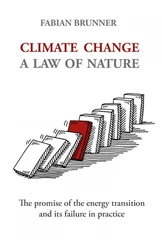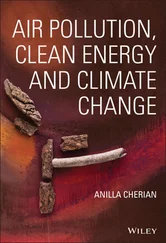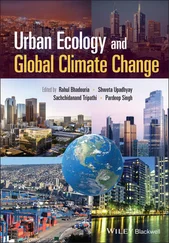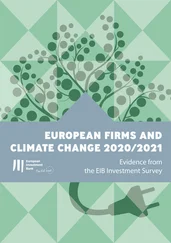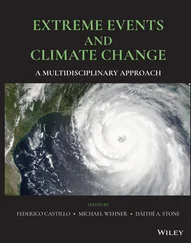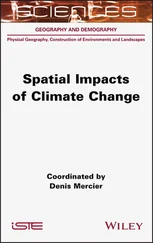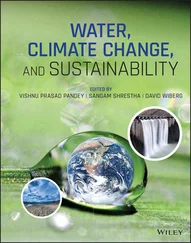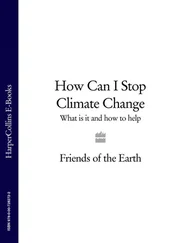1 ...8 9 10 12 13 14 ...22
Focusing On Carbon Dioxide: Leader of the Pack
Earth’s atmosphere contains 24 different GHGs, but just one of them accounts for the overwhelming majority of the effect: carbon dioxide (or CO 2, for short). This gas accounts for about 63 percent of the GHG warming effect in the long run. (In the short term, over the last 5 years, it has accounted for 91 percent. See Table 2-1for more on the intensity of gases over time.) If you’re itching to know about the other 37 percent of greenhouse warming, check out the section “ Checking Out the Other GHGs,” later in this chapter.
 Water vapor, not carbon dioxide, is technically the GHG with the biggest impact. But human activities don’t directly affect in a significant way water vapor in the atmosphere.
Water vapor, not carbon dioxide, is technically the GHG with the biggest impact. But human activities don’t directly affect in a significant way water vapor in the atmosphere.
Given the important role that carbon dioxide plays in warming the Earth, you may be surprised by how little of it is in the atmosphere.
 In fact, 99.95 percent of the air that humans breathe (not including water vapor) is made up of
In fact, 99.95 percent of the air that humans breathe (not including water vapor) is made up of
Nitrogen: 78 percent
Oxygen: 21 percent
Argon: 0.95 percent
Carbon dioxide, by contrast, currently makes up only 0.0412 percent of all the air in the atmosphere. Human activities have helped increase that concentration from pre-industrial times, when it was about 0.0280 percent.
When scientists talk about air quality and the chemistry of the atmosphere, they often use the term parts per million (ppm). So, currently out of every million parts of air, only 412 are carbon dioxide. That’s not much carbon dioxide, but what a difference it makes! Until recent changes in atmospheric chemistry caused by human activity, for around the last million years, carbon dioxide concentrations never exceeded 285 ppm. It’s like the hot pepper you put into a pot of chili — just right is just right, but if you have just a little too much, watch out.
The next sections explain the carbon cycle. If not for humans digging up the fossilized stored carbon of millennia ago — called fossil fuels — the Earth’s carbon cycle would have remained in balance. However, now the carbon cycle is out of balance. And that’s a key reason the weather and climate are no longer so hospitable.
Looking at the carbon cycle
Carbon dioxide occurs naturally — in fact, you, and every animal and insect on Earth that breathes in air, produce carbon dioxide every time you exhale. You inhale oxygen (and other gases), which your body uses as a nutrient, and you breathe out what your body doesn’t need, including carbon dioxide. You aren’t alone in using this process. But other organisms, mostly plants, suck carbon dioxide out of the air. Trees and grasses, for example, take in carbon dioxide and give out oxygen — the complete opposite of what people do.
The carbon cycle is the natural system that, ideally, creates a balance between carbon emitters (such as humans) and carbon absorbers (such as trees), so the atmosphere doesn’t contain an increasing amount of carbon dioxide. It’s a huge process that involves oceans, land, and air. Life as humans know it — from microscopic bugs in the oceans to you and me, and every fern and plant in between — would disappear without this cycle. You can think of the carbon cycle almost as the Earth breathing in and out.
 The carbon cycle is called in balance when roughly the same amount of carbon that’s being pumped into the air is being sucked out by something else. The atmospheric concentration of carbon dioxide was historically at a concentration of 280 ppm — carbon dioxide concentrations have fluctuated up and down through natural processes, but 280 ppm has been about the highest recorded concentration for the past 800,000 years — until recently when humans started to increase the concentration. (We look at how humans contribute carbon dioxide to the atmosphere in Part 2.)
The carbon cycle is called in balance when roughly the same amount of carbon that’s being pumped into the air is being sucked out by something else. The atmospheric concentration of carbon dioxide was historically at a concentration of 280 ppm — carbon dioxide concentrations have fluctuated up and down through natural processes, but 280 ppm has been about the highest recorded concentration for the past 800,000 years — until recently when humans started to increase the concentration. (We look at how humans contribute carbon dioxide to the atmosphere in Part 2.)
A RECIPE THAT GIVES YOU GAS
Carbon dioxide is composed of one carbon atom and two oxygen atoms. Present in the atmosphere as an odorless, colorless gas, it can also exist in solid form (think dry ice) and, when kept under pressure, in liquid form (the bubbles you see in champagne or a can of soda are carbon dioxide escaping after you uncork the bottle or open the can and remove the pressure).
When trees take up carbon through photosynthesis, they’re called carbon sinks. Plants aren’t the only carbon sinks, however. Figure 2-2 shows how the ocean, plants, and soil all act as carbon sinks, removing carbon from the atmosphere. They also store, or sequester, carbon, and they store the carbon in a carbon reservoir. For example, the ocean holds about 38,000 billion metric tons of carbon in its reservoir.
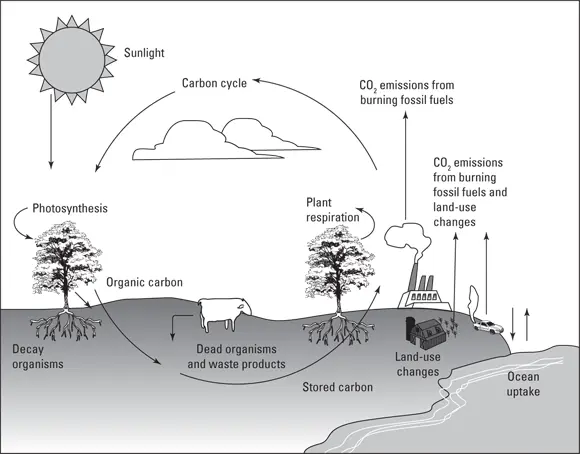
© John Wiley & Sons, Inc.
FIGURE 2-2:The carbon cycle.
The next sections explain how everything is connected. What goes on in the atmosphere isn’t isolated from everything else in the world. It’s like that old spiritual: “Dem bones, dem bones, dem dry bones. Toe bone connected to the foot bone. Foot bone connected to the heel bone. Heel bone connected to the ankle bone. Ankle bone connected to the leg bone …” and on and on. Earth is like that too. Everything is connected. The ocean is connected to the atmosphere. The plant life — forests on land and green things under water — are all connected. Changes in the atmosphere have impacts on the oceans, the forests, the clouds, and the soil. And vice versa.
The ocean is the biggest carbon sink on Earth. So far, it has tucked away about 90 percent of all the carbon dioxide in the world. If that gas was in the atmosphere, not underwater, the world would be a lot hotter.
The exchange of carbon dioxide between the ocean and the air happens at the surface of the water. When air mixes with the surface of the ocean, the ocean absorbs carbon dioxide because carbon dioxide is soluble in water (that is, carbon dioxide can be absorbed by water). And, in fact, the seas’ ability to absorb carbon dioxide is referred to as the solubility pump because it functions like a pump, drawing carbon dioxide out of the air and storing it in the ocean.
The ocean also acts as a biological pump to remove carbon dioxide from the atmosphere. Plants close to the surface of the ocean take in carbon dioxide from the air and give off oxygen, just like plants on land. (We discuss this process, known as photosynthesis, and the role that plants play in the carbon cycle in the following section.) Phytoplankton are microscopic plants that live in water. You may know them as algae, most commonly seen as the greenish clumpy plants that float around on ponds and other water. Phytoplankton have short but useful lives. If other organisms don’t eat them, they simply die within just a few days. They then sink to the ocean floor, mix into the sediment, and decay. The carbon dioxide that these plants absorb during their brief lives is well and truly sequestered after their little plant bodies are buried.
Each year, the oceans put away about another 2 billion metric tons of carbon dioxide. Figure 2-3 demonstrates how the ocean interacts within the carbon cycle. According to the World Economic Forum, recent research suggests that the 2 billion metric tons of carbon a year may actually be an underestimate. It could be as much as .9 billion metric tons more — every single year. Sometimes it’s expressed as ten Hiroshima-size nuclear bombs worth of energy in heating — absorbed by the oceans per second. Scientists writing about the huge amount of energy stored by the oceans search of explanations in equivalents that people can grasp — like nuclear bombs. That’s because the science is expressed in unfamiliar terms. Describing the energy in terms of nuclear bombs is a scientist’s way of expressing that the ocean absorbed 20 sextillion joules of heat in 2020.
Читать дальше
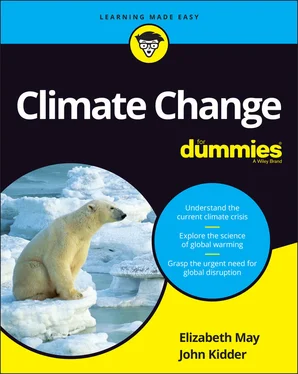
 Water vapor, not carbon dioxide, is technically the GHG with the biggest impact. But human activities don’t directly affect in a significant way water vapor in the atmosphere.
Water vapor, not carbon dioxide, is technically the GHG with the biggest impact. But human activities don’t directly affect in a significant way water vapor in the atmosphere. The carbon cycle is called in balance when roughly the same amount of carbon that’s being pumped into the air is being sucked out by something else. The atmospheric concentration of carbon dioxide was historically at a concentration of 280 ppm — carbon dioxide concentrations have fluctuated up and down through natural processes, but 280 ppm has been about the highest recorded concentration for the past 800,000 years — until recently when humans started to increase the concentration. (We look at how humans contribute carbon dioxide to the atmosphere in Part 2.)
The carbon cycle is called in balance when roughly the same amount of carbon that’s being pumped into the air is being sucked out by something else. The atmospheric concentration of carbon dioxide was historically at a concentration of 280 ppm — carbon dioxide concentrations have fluctuated up and down through natural processes, but 280 ppm has been about the highest recorded concentration for the past 800,000 years — until recently when humans started to increase the concentration. (We look at how humans contribute carbon dioxide to the atmosphere in Part 2.)
